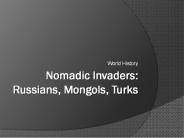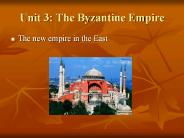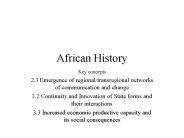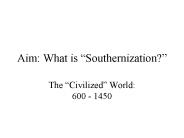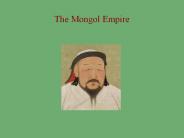Khanates PowerPoint PPT Presentations
All Time
Recommended
... Empire was divided into four large Khanates, each ruled by a descendant of Genghis ... Adoption of cultural practices drove the Khanates apart. Mongol Peace ...
| PowerPoint PPT presentation | free to view
AP World History Review Session 3: 1450-1750 Versailles Holy Roman Empire in 1630 Holy Roman Empire 1648 Ottoman Empire c.1300-1922 Mongol Khanates Muscovite State c ...
| PowerPoint PPT presentation | free to view
Picture take from Uzbekistan: History, Geography, Government, and Culture ... broke up into separate Uzbek principalities, the khanates of Khiva, Bukhara, and ...
| PowerPoint PPT presentation | free to view
Chapter 12 Section 2 Key Terms Pastroralists Clan Genghis Khan Pax Mongolica Nomads and the Asia Steppe Two Eurasia steppes Land trade route connector Home to nomadic ...
| PowerPoint PPT presentation | free to view
Mongols Genghis Khan conquered the other tribes Expanded his Empire until he died in 1227 Successors continued to expand Power struggles after his son Ogedei died ...
| PowerPoint PPT presentation | free to view
The Mongol Conquest Asian Nomads Mongolian Steppe- grassland, good trade route and pastures Pastoralists- herd domesticated animals Always moving with seasons Traded ...
| PowerPoint PPT presentation | free to download
SSWH4b,d: The Russian Empire and the Mongol Empire Chapter 11.2 Pages 307-311 Chapter 12.2 & 12.3 Pages 330-338 The Rise of the Mongols Problems Between Steppe ...
| PowerPoint PPT presentation | free to view
World History Nomadic Invaders: Russians, Mongols, Turks Birth of Russia Blending of Slavic and Greek traditions Adventurers came down from the north and settled in ...
| PowerPoint PPT presentation | free to download
Genghis (Chinggis) Khan (Universal Ruler) / Temujin Rise to power illustrates the fluidity of nomadic society Unifies all the tribes, but he needed enemies ...
| PowerPoint PPT presentation | free to download
The Mongol Conquests 12.2 The Mongolian conquests forever changed Asia and Europe. While the Song dynasty prospered, Northern China also prospered.
| PowerPoint PPT presentation | free to view
Introduction to the Silk Road Antiquity s Internet Highway How has the evolution of the Silk Roads impacted cultural diffusion within modern society?
| PowerPoint PPT presentation | free to view
Unit: The Age of Empires Topic: The Rise of the Mongols ... The Mongols
| PowerPoint PPT presentation | free to download
Unit 3: The Byzantine Empire The new empire in the East Geography Constantinople Location The Bosporus strait Trade Defense Walls Moat Peninsula Geography and natural ...
| PowerPoint PPT presentation | free to view
African History Key concepts 2.3 Emergence of regional/transregional networks of communication and change 3.2 Continuity and Innovation of State forms and their ...
| PowerPoint PPT presentation | free to download
... late 13th century Travels of Marco Polo - 13th century Travels of Ibn Battuta - 14th century Voyages of Zheng He, early 15th century Zheng He s ships, ...
| PowerPoint PPT presentation | free to download
Unit: The Age of Empires Topic: The Rise of the Mongols ... The Mongols
| PowerPoint PPT presentation | free to view
Mongol Eurasia & Its Aftermath 1200-1500 Nomadism in Central Asia Resources Scarce water = Pressure for tribes to move out to find new sources Complex Hierarchy ...
| PowerPoint PPT presentation | free to download
... Empire in 1227 Mongol War Machine Conquest after Genghis Khan Mongol Empire after 1227 The Mongol Empire Yuan Dynasty Yuan Social Policies Mongol ...
| PowerPoint PPT presentation | free to view
Mongol Collapse . The empire began to collapse after rebellion in China . In the 1360s Timur-i Lang attempted to reestablish the Mongol empire . Instead his forces ...
| PowerPoint PPT presentation | free to download
Empires in East Asia, 600 1350 Several kingdoms and empires arise in East Asia, helping to spread Hinduism and Buddhism, as well as trade, technology, and culture.
| PowerPoint PPT presentation | free to view
History 210: The late, great Mongol Empire: origins, spread, and progeny Who were the Mongols? Nomads, pastoralists: Xiongnu (Huns) Magyars Mongols Pastoralism, trade ...
| PowerPoint PPT presentation | free to view
Term used to describe the rivalry and strategic conflict between the British ... Central Asia, circa 1848. Like a Mighty Chess Game...
| PowerPoint PPT presentation | free to view
I. The Rise of the Mongols
| PowerPoint PPT presentation | free to view
The Mongols - Yola ... The Mongols
| PowerPoint PPT presentation | free to download
Title: Mongols and Europeans Author: john.cofield Last modified by: Matt Bartula Created Date: 10/6/2006 11:44:01 AM Document presentation format
| PowerPoint PPT presentation | free to view
Chapter 12 Mongol Eurasia and Its Aftermath, 1200-1500 AP World History Ivan the Terrible First Russian prince to fight the Golden Horde.
| PowerPoint PPT presentation | free to download
Title: No Slide Title Author: Matt Hamlyn Description: email mhamlyn@jessamine.k12.ky.us Last modified by: CUSD95 Created Date: 10/7/1999 5:16:48 PM
| PowerPoint PPT presentation | free to download
I. The Rise of the Mongols B. Yuan Organization 1. highly centralized: Mongols ruling elite -Mongols: top posts -Persians, Turks, Nomads: high civil ...
| PowerPoint PPT presentation | free to download
The Pax Mongolica allowed for exchange of ideas through cultural diffusion including ideas of technology. Trade was enhanced by connecting Europe, Middle East, Russia ...
| PowerPoint PPT presentation | free to download
Unit II: 600-1450 C.E. Big Picture Themes: Rebuilding of Declining Empires ( Post-Classical ) Rise & Spread of Islam Centralized VS. Decentralized Empires
| PowerPoint PPT presentation | free to download
The Mongol Empire Timur the Lane Attempted to reunite to the Mongol Empire. Yet fought against other branches of the Empire (Mostly the Golden Horde).
| PowerPoint PPT presentation | free to download
The Muslim World Expands Ch 18 1300-1700 Islam + Muslims Islam is the religion, a Muslim is a follower. Islam means, submission to the will of Allah Allah ...
| PowerPoint PPT presentation | free to download
Title: Chinese Nationalism Author: jhauck Last modified by: JHauck Created Date: 2/17/2004 3:38:44 PM Document presentation format: On-screen Show (4:3)
| PowerPoint PPT presentation | free to view
... (Mongolia and China) Khanate of Chagatai (Central Asia) The Ilkhanate (Persia) Khanate of the Golden Horde (Russia) CHALLENGE QUESTION! IV.
| PowerPoint PPT presentation | free to download
Mughal Empire and its founders
| PowerPoint PPT presentation | free to download
Turkish & Mongol invasions perhaps the most important to world history ... India helpless to Turkish onslaught. only one warrior class. rest converted to Islam ...
| PowerPoint PPT presentation | free to view
AP World History Review Session 3: 1450-1750 European New World Colonies Spain & Portugal Hapsburg Empire 16th century England Puritan Migration to North America ...
| PowerPoint PPT presentation | free to view
History: The late, great Mongol Empire: origins, spread, and progeny Who were the Mongols? Nomads, pastoralists: Xiongnu (Huns) Turks Mongols Pastoralism, trade ...
| PowerPoint PPT presentation | free to view
Arial Calibri Default Design Slide 1 Slide 2 Slide 3 Slide 4 Slide 5 Slide 6 Slide 7 The Mongol Empire at Genghis Khan s Death in 1229 Slide 9 Slide 10 Slide 11 ...
| PowerPoint PPT presentation | free to view
III. Cross-cultural exchanges were fostered by the intensification ofexisting, or the creation of new, networks of trade and communication. Islam, based on the ...
| PowerPoint PPT presentation | free to download
III. Cross-cultural exchanges were fostered by the intensification ofexisting, or the creation of new, networks of trade and communication. Islam, based on the ...
| PowerPoint PPT presentation | free to download
Flags, hand signals. Tactics: retreat, turn, flank, destroy ... Persians, Turks, Non-Chinese nomad stock: High civil posts ... The Hundred Years War ...
| PowerPoint PPT presentation | free to view
Chapter 10 From the Tang to the Mongols: The Flowering of Traditional China China after the Han (220-581) Division and civil war Nomads from the Gobi Desert Decline ...
| PowerPoint PPT presentation | free to download
Mongolians had kingdoms in northern China in 4th & 10th centuries. disciplined army ... rule from Persia to north China Sea. son Ogedei named grand Khan ...
| PowerPoint PPT presentation | free to view
(struggle for dominance in the region by the Turkic and Mongol tribes) ... No one in the army was paid, though all shared to varying degrees in the booty. ...
| PowerPoint PPT presentation | free to view
Mongols The Mongols made no technological breakthroughs, founded no new religions, wrote few books or dramas Why historically significant?
| PowerPoint PPT presentation | free to view
Chapter 14 The Last Great Nomadic Challenges: From Chinggis Khan to Timur I. The Mongol Empire of Chinggis Khan Mongol Culture Nomadic pastoralists Goats, sheep Tribe ...
| PowerPoint PPT presentation | free to view
AKS 33: The Byzantine Empire and the Mongol Empire Chapter 11.1 & 11.2 Pages 301-313 Chapter 12.2 & 12.3 Pages 330-338 Kiev becomes linked to Constantinople ...
| PowerPoint PPT presentation | free to download
Divided government functions into six ministries ... Invented compass, printing press, and gunpowder. Doctors took pulse to aid in diagnosis ...
| PowerPoint PPT presentation | free to view
AP World History Review Chapters 11-13 Part I Dear students Note to students: Although I wasn t able to finish this for you, that doesn t mean you can t ...
| PowerPoint PPT presentation | free to view
Several kingdoms and empires arise in East ... Rulers build temple complexes in capital, Angkor. Angkor Wat square mile complex dedicated to Hindu god Vishnu ...
| PowerPoint PPT presentation | free to view
AP World History II Review The Delhi Sultanate The Gupta Empire collapses in 550 CE Muslim forces enter the subcontinent in the 700s After the capture of Delhi, the ...
| PowerPoint PPT presentation | free to view
State-building, expansion and conflict Political structures and forms of governance Empires Nations and nationalism Revolts and revolutions Regional, transregional ...
| PowerPoint PPT presentation | free to view
The exchange and subsequent transformation of things, ideas, religious and ... 'Kamikaze' or 'divine wind' Inspiration for WWII 'kamikaze' The Mongol Art of War ...
| PowerPoint PPT presentation | free to view
The Japanese called these storms kamikaze which means divine wind ('How'). The Myth of the Kamikaze. Works Cited 'Arts of Asia.' The Minneapolis Institute of Arts. ...
| PowerPoint PPT presentation | free to view
Title: AP World History Review Author: Donnie Huckaby Last modified by: alase Created Date: 4/18/2002 3:59:08 PM Document presentation format: On-screen Show (4:3)
| PowerPoint PPT presentation | free to view








